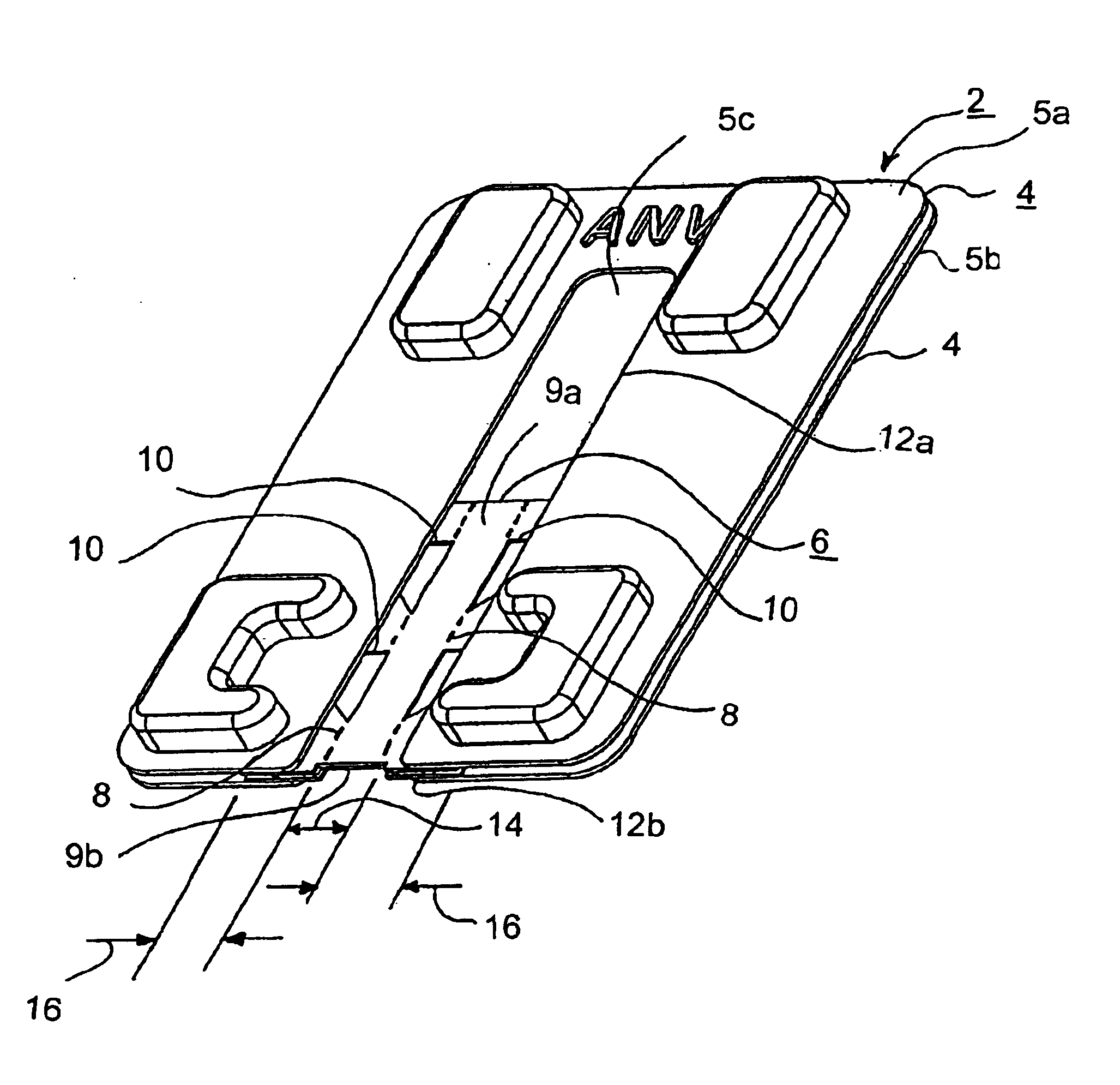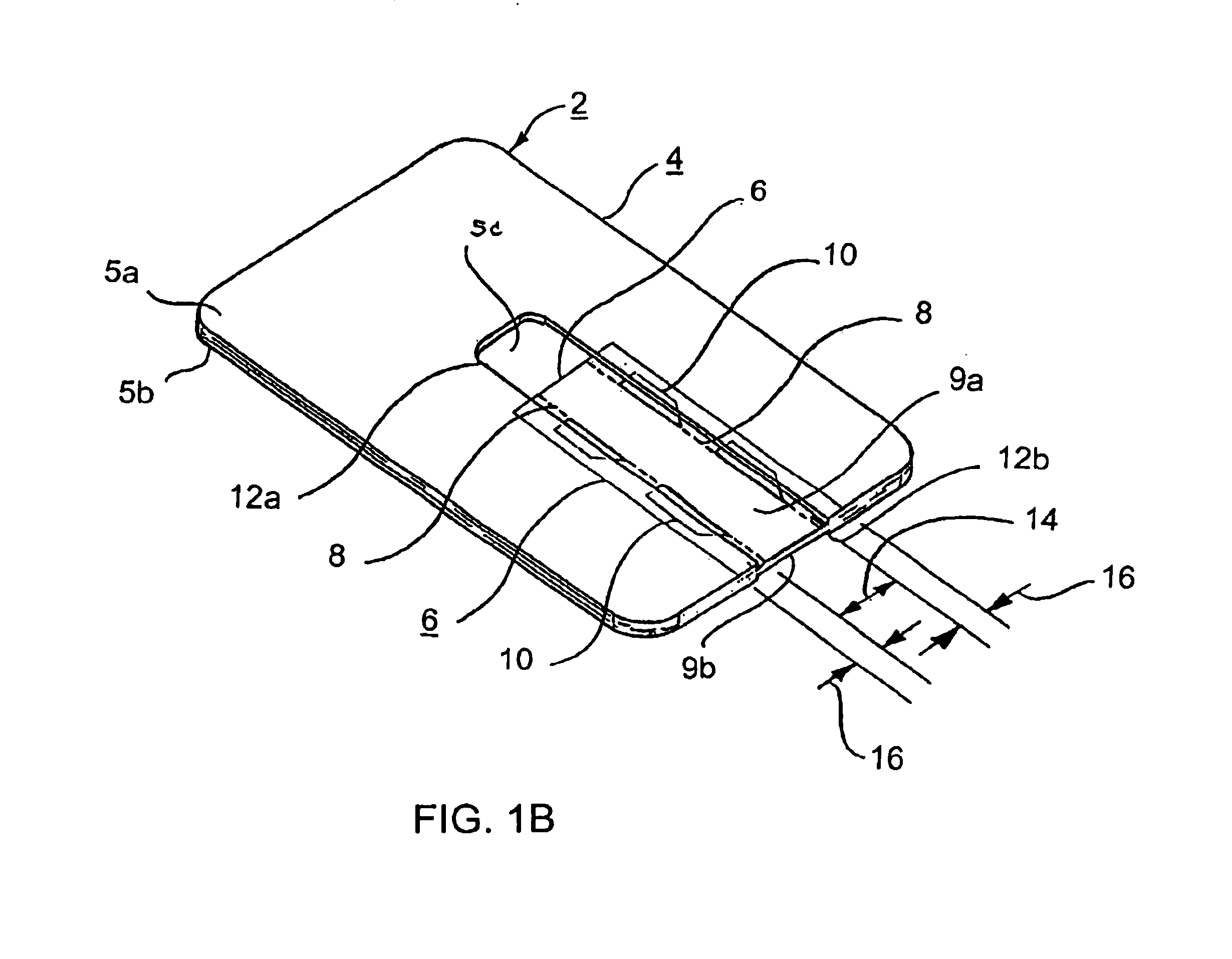Apparatus and method for applying reinforcement material to a surgical stapler
a technology of reinforcement material and surgical stapler, which is applied in the field of surgical staple devices, can solve the problems of slow healing, too fragile tissue being sealed to securely hold the staples in place, and the procedure is much faster than before, and achieves the effect of accurate sizing of reinforcement material and simple manufacturing
- Summary
- Abstract
- Description
- Claims
- Application Information
AI Technical Summary
Benefits of technology
Problems solved by technology
Method used
Image
Examples
example 2
[0088]A package was constructed to apply surgical staple reinforcement material to the arms of a Model ETS 45 surgical stapler available from Ethicon, Somerville, N.J. The basic configuration of this example is shown in FIG. 14. Shown is a package 2 for applying surgical staple reinforcement material to the arms of a surgical stapler. The package 2 comprised an application card 4, with a first portion 5a, a second portion 5b, and a landing 110 against support layer 5C. The package 2 further comprised a reinforcement material 6 having a first portion 112 adapted to be attached to the jaws of the aforementioned family of surgical staplers. The reinforcement material 6 had a second portion 114, attached to the application card 4. Tear lines 8 separated the first portion 112 and second portions 114 of the reinforcement material 6. An adhesive 116 was attached to the first portion 112 and second portion 114 of the reinforcement material 6. The attachment of the second portion 114 to the ...
example 3
[0100]A package was constructed to apply surgical staple reinforcement material to the arms of a Model EZ 45 surgical stapler available from Ethicon, Somerville, N.J. This package was similar to the package of Example 2 with the exception of details designed to accommodate the raised scalpel blade stop located on astapler cartridge. Shown on FIG. 17 is the cartridge portion of the reinforcement material 6 of the present example. Shown is the first removable portion 112 and the second retained portions 114 of the reinforcement material 6. Within the removable portion 112 was a clearance hole 186, designed to provide clearance for the raised scalpel blade stop located on the Model EZ 45 stapler cartridge. Elements 188 and 190 locate the approximate center of the oval shaped clearance hole 186, which had a long vertical axis of about 2.3 mm and a shorter horizontal axis of about 1.8 mm. Dimension 188 was about 5.8 mm and dimension 190 was about 15.3 mm. The tear lines on the cartridge ...
example 4
[0104]As has been noted, it may be desirable to include a separate piece of foam or other resilient material with the package of the present invention to aid in reapplying staple reinforcement material that might separate from the stapler arms prior to application and / or to provide a surface against which to improve sealing of the reinforcement material prior to use.
[0105]One example of such resilient material 200 is illustrated in FIG. 19. This material comprised a pentagonal shape of polyether-urethane foam, with about a 1.6 # density acquired from Pacfoam, Costa Mesa, Calif. This foam piece was about 10.5 cm along dimension 202, about 4.5 cm along dimension 204, and 6.5 cm along dimension 206. The foam was approximately 7 mm thick.
[0106]Use of similar resilient material 208 is illustrated in FIGS. 20A through 20D. A stapler assembly 20, having anvil 22 and cartridge 24, with staple reinforcement material 6 applied to each of the anvil 22 and cartridge 24, was positioned around th...
PUM
 Login to View More
Login to View More Abstract
Description
Claims
Application Information
 Login to View More
Login to View More - R&D
- Intellectual Property
- Life Sciences
- Materials
- Tech Scout
- Unparalleled Data Quality
- Higher Quality Content
- 60% Fewer Hallucinations
Browse by: Latest US Patents, China's latest patents, Technical Efficacy Thesaurus, Application Domain, Technology Topic, Popular Technical Reports.
© 2025 PatSnap. All rights reserved.Legal|Privacy policy|Modern Slavery Act Transparency Statement|Sitemap|About US| Contact US: help@patsnap.com



